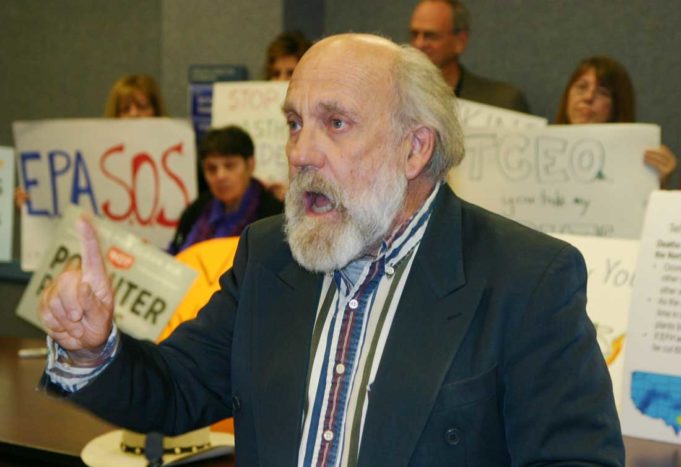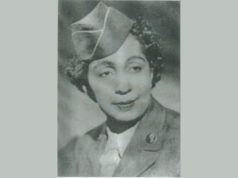Exhaust emissions from Tarrant County cars create poor air quality around here, but other factors are making it hard for people to breathe, particularly folks with asthma. Summer winds carry pollutants here from three outdated coal-fired power plants in East Texas and from several pollutant-spewing industrial plants in Midlothian, 30 miles to the southeast.
As the wind blows, so go the environmental activists. Recently, they’ve been hounding Dallas officials to become more proactive about reigning in those power plants, all owned by Energy Future Holdings (TXU Energy, Luminant, and Oncor), currently involved in bankruptcy proceedings. Dallas County Commissioners responded in November by passing a resolution to pressure a bankruptcy court to insist on any new owner to clean up or phase out those coal-powered plants, known as Big Brown, Martin Lake, and Monticello.
One of the most vocal environmentalists is Jim Schermbeck of Downwinders at Risk, a grassroots group of activists and community organizers in North Texas. His group will continue heading west, he said.
“We are going to be showing up in Fort Worth and Tarrant County eventually to get resolutions passed to reject the state air plan,” he said.
The state air plan, if you listen to environmentalists, is no plan at all. Rather, it’s a continued lack of action based on Texas governmental policies that promote a mostly hands-off regulatory approach to big business. Many activists and news media reporters have discovered over the decades that state agencies charged with overseeing industries are, in many instances, protecting them from public scrutiny instead. For instance, by doing little to police drill sites and insist on healthy air, Texas Railroad Commission members basically allow their elections to be funded by oil and gas drillers. And the members of the Texas Commission on Environmental Quality, the state group responsible for managing the air we breathe, are appointed by Texas governors who like tax-generating businesses regardless of their environmental damage.
TCEQ hosted a public hearing on its state air plan last month in Arlington, and Schermbeck and about 100 other residents showed up to voice their concerns. Let’s just say it wasn’t exactly a lovefest. Expressing complete lack of confidence in the state agency was Tom “Smitty” Smith of Public Citizen, a national nonprofit group that says it “serves as the people’s voice in the nation’s capital.” Smith directs the group’s Texas office and has testified more than 1,000 times before the Texas Legislature and Congress.
He also has pushed for two decades for TCEQ officials to try and come up with a clean air plan that reduces smog in North Texas.
“For the 20 years I’ve been working with y’all on these plans, everyone of those plans has failed to reduce the air quality pollutants enough to bring safe air to the Dallas/Fort Worth area,” he told TCEQ officials at the hearing.
Enforcing stricter standards on the coal-powered plants as well as on the Midlothian plants and the oil and gas industry could improve the air quality enough to put North Texas in compliance with federal standards for the first time, he said.
“In 2007, y’all did studies that indicated if you just put pollution control on Big Brown, Monticello, and Martin Lake, it would make a huge decrease in the emissions that are causing air pollution in the D/FW area,” Smith said.
An American Lung Association air quality report released last year gave Tarrant County an “F” for its ozone levels, the worst possible grade.
The Texas Medical Association helped fund a report several years ago in which the three 1970s-era coal-fired plants were studied. They were dubbed major emitters of air pollutants and greenhouse gases in Texas. The pollutants are known to contribute to breathing problems for children and adults living in smoggy communities. The report suggested using selective catalytic reduction (SCR) equipment to reduce emissions at the plants.
Environmental groups such as Public Citizen funded another report relying on TCEQ information that showed similar results.
“While y’all have quit really looking for solutions to air quality in the Dallas/Fort Worth area, the folks at the University of North Texas, funded by a group of us, used your models and your data and determined that if you just put the same pollution controls that have been on our cars since 1977 on those old coal plants, that you would reduce emissions enough to attain the [federal Clean Air Act] standard,” Smith said.
He saved his harshest criticism for last.
“Why is it that we in Texas continue to have hope that TCEQ will do that job?” Smith said. “Well, we’re announcing that we don’t believe it anymore, and we’re asking the federal government and the Environmental Protection Agency to come in and do a federal implementation plan to finally clean up the air in Texas. We’ve learned time and time again, whether it be on air quality or civil rights or water protection or haze, about the only time we make significant progress is when the federal government walks in and says, ‘We’re going to shut you down and take it over.’ Now is the time for us once again to say this plan fails, you all have failed, your commissioners have failed, our governor has failed. Failure should not be rewarded.”
The crowd applauded as Smith returned to his seat.
TCEQ officials deny being soft on pulluters. Agency spokesperson Andrea Morrow said the Texas Emissions Reduction Program has funded $327 million for projects that have reduced over 58,000 tons of nitrogen oxide in the D/FW area. The state has also adopted a program to assist eligible citizens in repairing or replacing vehicles that do not pass emissions inspections. Specifically, this program has provided financial assistance for repairing and replacing a total of 17,197 and 28,951 vehicles in the D/FW area.
Activists are off base by calling for Texas to adopt a federal rather than state plan, she said.
“We don’t believe a federal plan for ozone will lead to better air quality in the D/FW area,” Morrow said in a written response to the Weekly’s questions. “There are state rules in place that address coal-fired plants in East Texas, the Midlothian plants, and the oil and gas industry. The rules were included in previous state plans and we have a history of working with EPA throughout the process to gain approval of the rules and plan.”
The state’s current proposed plan contains no new controls on emission limits beyond what is already in place. And activists complain that the controls already in place aren’t working. But TCEQ officials point out that plant operators and activists have wildly different expectations.
“Critics wanting more stringent environmental regulations are prone to say the requirements are not strict enough, and critics wanting less environmental requirements are prone to say the requirements are too onerous,” Morrow said.
The EPA will eventually decide whether to approve or disapprove the state plan, which could take six months to a year, Schermbeck said. He and other activists plan to use that time to get resolutions passed supporting the federal plan over the state plan.
“We need local political support to pull this off,” Schermbeck said. “The state plan is a do-nothing plan. There are no actual new pollution controls in this plan at a time when smog levels are increasing.”
Schermbeck visited Tarrant County commissioners in the late 2000s during his so-called “green cement campaign.” He asked commissioners to pass a resolution saying the county wouldn’t use cement from the dirty Midlothian plants for municipal and county projects. Dallas had adopted green cement policies in 2007. Tarrant County followed suit the next year.













Clarification: Downwinders at Risk raised $120,000 to finance the UNT Project, primarily from The Harold Simmons Foundation, Trammell S. Crow, Garrett Boone and the Dallas Foundation. The study cloned the TCEQ computer model used for the DFW air plan and ran analysis the state had refused to run showing how cuts in sources would impact smog levels. More information at: http://dfwozonestudy.org/
My husband works in construction and sent me a text last week to say he was in Dallas on the fifth floor of a construction project looking west and saw what my son and I was breathing in Arlington…”nasty, brown, air”. He said one day he’d rescue us away from all this smog. #oneDaysomeDaymayB2late #fracked we R!